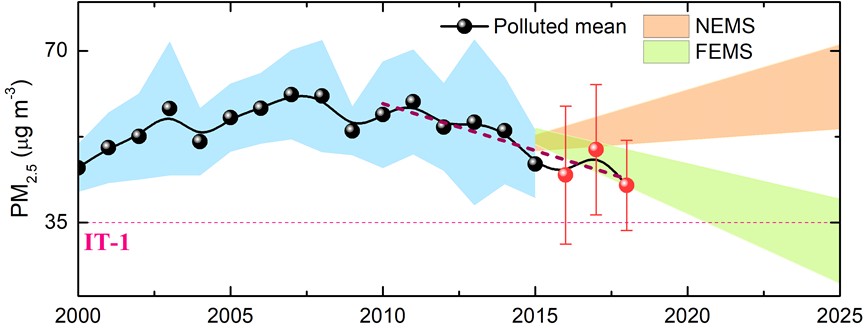Satellite Observation-Based Study Reveals Historic Changes of PM2.5 over China and Trend Analysis
A research team led by Prof. LI Zhengqiang from the National Engineering Laboratory of Remote Sensing Satellite Application under the Aerospace Information Research Institute (AIR), Chinese Academy of Sciences (CAS), has made progress in satellite observations of the historic changes of PM 2.5 and predictions of trends over China. The paper titled “Satellite Observations of PM2.5 Changes and Driving Factors Based Forecasting Over China 2000–2025” was published online in the journal of Remote Sensing.
In this study, a recently developed formulation for the calculation of surface PM2.5 concentrations using satellite data is introduced and applied to reconstruct a PM2.5 time series over China from 2000 to 2015. The formulated model is also used to explore the PM2.5 driving factors related to anthropogenic or meteorological parameters in the period.
The results show that the annually average PM2.5 over China’s polluted regions increased rapidly between 2004 and 2007 (with an average rate of 3.07 μg m-3 yr-1) to reach values of up to 61.1 μg m-3 in 2007, and decreased from 2011 to 2015 with an average rate of -2.61 μg m-3 yr-1, to reach a value of 46.9 μg m-3 in 2015.
The analysis shows that the increase of PM2.5 before 2008 was mainly associated with increasing anthropogenic factors, further augmented by the effect of meteorological influences. However, the decrease in PM2.5 after 2011 is mainly attributed to the effect of pollution control measures on anthropogenic factors, whereas the effects of meteorological factors have continued to increase since 2000.
Based on trend analyses of anthropogenic and meteorological drivers, the average PM2.5 concentrations in polluted regions of China are expected to decline to 35 μg m-3 in 2021 in a scenario where emissions continue to decrease and meteorological factors are favorable. However, if emissions are held constant at current levels, meteorological drivers will lead to a rebound of PM2.5 concentrations in the future. These results strongly support continuous efforts for anthropogenic emission control to achieve a big decline of PM2.5 pollution in China.

Figure 1. Satellite-derived annual mean PM2.5 mass concentrations and predictions for two different emission control scenarios over the five polluted areas.



News & Events